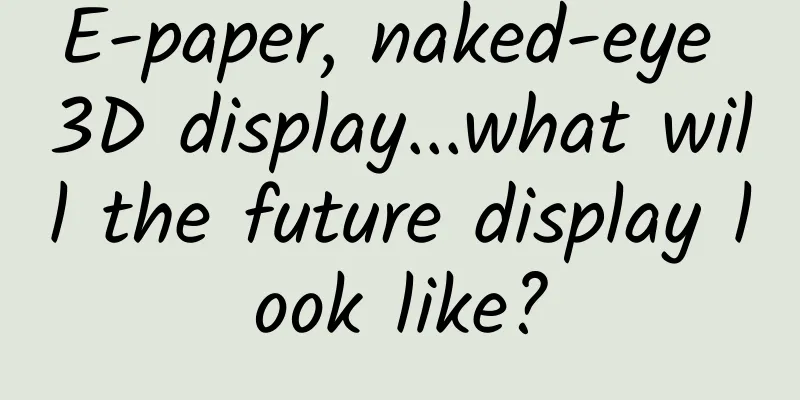E-paper, naked-eye 3D display...what will the future display look like?

|
Produced by: Science Popularization China Author: Wang Zhihao Producer: China Science Expo Human beings' demand for sound, light and color has given rise to a variety of information carriers, and display technology has also been greatly developed. Plasma TVs, LED TVs, LCD monitors... these are the mature display methods we are more familiar with. In addition, there are some new display technologies with a futuristic feel that are gradually entering our lives. 1. Quantum dot display technology Quantum dots are zero-dimensional dot-shaped nano-semiconductor materials that have many novel electronic and optical properties and can be used in many fields, such as display technology. There are two main display technologies using quantum dots, namely quantum dot liquid crystal display (QD-LCD) based on liquid crystal display technology and quantum dot light-emitting diode display (QLED) based on OLED. QLED TV (Image source: wikipedia/Bretwa) QD-LCD mainly uses the photoluminescence principle of quantum dots. After the blue light emitted by the LED light source in the backlight module passes through the quantum dot film, part of it is converted into green light and red light by the quantum dots. These three colors of light are mixed into the white backlight source of the LCD. The light source of traditional LCD is generally LED, but the color light it emits is not pure. The green and red light emitted by quantum dots are purer than the light emitted by LED. Therefore, the addition of quantum dot film can make LCD display more realistic image colors and more natural color transitions. The principle of QD-LCD (from left to right, the LED light source emits blue light, which passes through the quantum dot film to display a variety of colors on the screen) (Image source: Lee J H. QD Display: A Game‐Changing Technology for the Display Industry[J]. Information Display, 2020, 36(6): 9-13.) QLED mainly utilizes the electroluminescence principle of quantum dots. It drives the quantum dots themselves to emit the three primary colors of red, green and blue through voltage, and converts these three colors into pixels of various colors through spatial color mixing. The light-emitting principle of QLED is very similar to the common OLED screens we have now, except that the light-emitting organic materials in OLED are converted into quantum dot materials. This also makes QLED have almost all the advantages of OLED, and has a longer life and brightness than OLED. So in fact, QLED is a more advanced application of quantum dots in the field of display technology. However, quantum dot displays are currently rare on the market, are expensive, and are still in the optimization stage. However, it has many advantages that other technologies cannot match, which also makes it a hot spot for corporate research and application. 2. Laser display technology As another of the greatest inventions of mankind in the 20th century after atomic energy, computers, and semiconductors, laser is known as the "fastest knife", "most accurate ruler", and "brightest light". After entering the 21st century, the application of laser technology has entered a glorious stage, playing a very important role in various fields such as machinery manufacturing, aerospace, lighting, medical treatment, and military. As a high-quality light source, laser is of course also used in display technology. Laser TV, as the name implies, is a TV that uses laser as a display light source. Due to the excellent monochromaticity of laser, the color effect of the TV is excellent. Although it is called laser TV, this display technology is actually more like a projector. However, unlike the longer projection distance required by a projector, laser TV uses ultra-short-throw projection to illuminate the laser light source onto an anti-glare screen to produce a display effect that is better than that of traditional projectors and TVs. The laser TV on the table in the lower left picture is actually an ultra-short-throw projector. (Image source: Wikipedia) But lasers are both a success and a failure. Laser light sources are expensive, especially green lasers, which are not only expensive but also have a short lifespan, so laser TVs are very expensive. However, as more and more manufacturers invest their R&D efforts in the field of laser TVs, it may become a strong competitor in the future of TVs. 3. Electronic paper display technology Paper has been around for 2,000 years and is still widely used in society today. Reading paper books often brings a peaceful experience. However, in addition to traditional paper and screens, there is now a product that combines the characteristics of both - electronic paper. Electronic paper is not paper. It is also called electronic ink screen. It is a special display screen. The image displayed by electronic paper is like a picture printed on paper. This unique display effect also makes it a promising substitute for paper. The display of electronic paper mainly comes from the countless ink particles in the middle layer of the screen. The particles are filled with a transparent base liquid, in which positively charged white ink and negatively charged black ink are suspended. The ink is about the same size as the diameter of a human hair. When a negative electric field is applied to the ink particles, the white ink will move to the negative pole of the electric field under the action of the electric field, while the black ink will move to the positive pole of the electric field. The positive pole is inside the screen, so it is hidden, and the pixel will display white. Similarly, when a positive electric field is applied, the pixel will display black, and countless pixel combinations will form an image. Black and white electronic paper schematic (Image source: Eink promotional image) Electronic paper has another special feature: even if the power is turned off, the ink distribution on the screen will not disappear. This is a feature that other types of screens do not have. From the principle, we can understand that electronic paper does not need a backlight. Electronic paper is a reflective display device, that is, it displays images by reflecting ambient light, and the brightness of the image changes according to the intensity of the ambient light. Therefore, electronic paper has advantages that ordinary screens cannot match, such as eye protection, ultra-low power consumption, comfortable reading, and good visibility in the sun, unlike mobile phone screens, which are difficult to see in the sun. The electronic paper screen under the sun is non-reflective and clearly visible (Image source: Wikipedia) Black and white electronic paper is more common on the market now. Of course, color electronic paper has also appeared later. They either place a color filter on the ink particles, or replace them with colored ink particles, and use electric fields to change the different positions of different colored inks in the particles. After mixing, they can show various colors. Of course, due to technical limitations, it can only be called color. It is still a bit "forcing" to compare its color vividness with that of conventional displays. Color electronic paper schematic (Image source: Eink promotional image) At present, the capabilities of electronic paper cannot replace LCD displays. It is positioned to replace paper and printed materials. However, in the future, electronic paper will definitely develop in various directions such as full color, improved response and lower cost. The Future of LCD——Mini/Micro-LED The more popular LCD LED displays and OLED displays now have their own advantages and disadvantages. The color uniformity of LCD LED displays is relatively poor, and although OLED displays have solved the problems of contrast and uniformity, their service life is relatively short. At this time, the display technology sandwiched between the two - Mini/Micro-LED can perfectly make up for their shortcomings and have their advantages. The difference between Mini LED backlight and traditional backlight LED beads (Image source: Geek Research Monk) If you want to solve the problems of insufficient contrast of LED screens and severe halo in black parts, the most feasible way is to reduce the size of LED light sources, in other words, to increase the number of LED lamp beads under the same size display. As long as the size of LED lamp beads is continuously reduced, and finally even as small as pixels, LCD will have image quality comparable to OLED, while also having the long life that OLED lacks. This is also the origin of the name of Mini/Micro-LED display. The diameter of Mini LED LED lamp beads is about 50-200μm, and Micro LED lamp beads are even smaller, usually less than 50μm in diameter. Edge-type LED backlight and halo display of different partitioned Mini LED backlight (Image source: Geek Research Monk) Although the partitioned backlight Mini-LED display with tens of thousands of LED lamp beads has entered the market, this is just the beginning. Mini-LED displays do not have enough lamp beads and partitions, which will lead to severe halo and low contrast in scenes with rich dark parts. As shown in the figure above, the halo of the Mini-LED display with fewer partitions is still clearly visible. Micro LED can theoretically perfectly solve the above problems of Mini LED, but making LED pixel particles so small is an extremely delicate task, and the number of control chips required for so many lamp beads is unimaginable. Therefore, at present, it can only appear in exhibitions where cost is not taken into account for showing off skills. If it is really to be popularized and applied, it will take a long time for technological breakthroughs. Micro LED Structure (Source: Shenzhen National High-Tech Industry Innovation Center, Tianfeng Securities Research Institute) The foundation of the Metaverse — VR, AR, MR, XR, and ER Once upon a time, VR and AR were hot publicity gimmicks, and various head-mounted devices emerged one after another, as if the future scenes in science fiction movies were within reach. Now the hype around VR and AR has gradually subsided. But with the rise of the metaverse, VR seems to have regained vitality. VR and AR are often mentioned, in addition to MR, XR and ER. It is hard to tell them apart, but after reading the following description, you will have a clearer understanding of their concepts. VR stands for Virtual Reality, which replaces the real world with a world completely generated by computers. Typical applications are various VR glasses and VR games. AR is called augmented reality. Unlike VR which directly replaces the real world, AR adds virtual objects to the real world to enrich the real world. Mixed reality (MR) refers to a new visual environment created by the fusion of the real and virtual worlds, in which real entities and digital entities coexist and can interact in real time. In other words, the generated "virtual images" can interact with real objects to a certain extent. Extended reality (XR) includes augmented reality, virtual reality, mixed reality and other forms, ranging from virtual worlds with limited sensor input to fully immersive virtual worlds. Simulated reality (ER) is to use the existing VR, AR, 3D modeling, high-definition display, full interaction and other technologies to the extreme to create a completely identical real world. A classic example of a simulated world is the future world in the famous movie "The Matrix". VR Technology (Photo source: Veer Gallery) The most common technology we are currently exposed to is VR, which uses the principle of visual error of the human eye: due to the different positions of the two eyes, there is a difference in the images seen by the two eyes, so that the three-dimensional sense of space can be perceived. VR technology uses binocular stereoscopic vision to make the left and right eyes see different images to create a visual error, which cannot be brought to us by flat-panel displays. However, current technology cannot achieve true simulation at all, because this not only places extremely high demands on the complexity of the virtual environment, but also on image quality and refresh rate. Therefore, at this stage, when we put on VR glasses to experience virtual reality, we feel more like "virtual" rather than "real". However, the development of virtual reality technology still has great possibilities. It has huge development potential and applications in industry and research. The equipment related to it is the foundation of the birth of the metaverse. Future technology - naked eye 3D display There are many devices that can help us show three-dimensional effects on two-dimensional images. In fact, they all use the perception of the human visual system. The human visual system obtains a lot of information from the outside to perceive depth, and most of the important depth perception elements are two-dimensional information, including shadows, perspective direction, relative size, occlusion and blur. After the two-dimensional depth perception elements pass through the human visual system, we will think of it as a ball existing in three-dimensional space. Whether it is a painting, a photo, or an image, as long as the two-dimensional depth perception elements are implanted, our eyes will produce a three-dimensional perception effect, otherwise an optical image illusion will occur. Therefore, the 3D display system must first ensure the above two-dimensional depth perception elements, and then add and solve other three-dimensional perception elements, such as stereoscopic parallax, motion parallax and visual adjustment conflict, etc. Based on this principle, people have obtained several technical directions for realizing 3D display. VR is a device that uses binocular parallax as a technical direction to realize 3D display. But if we want to wear a variety of devices that block our eyes, If we want to realize naked eye 3D, this is a new problem. However, holographic 3D display may bring us such an experience. Compared with binocular parallax that can cause dizziness and other discomfort, holographic three-dimensional display can record and restore all the information of the object's light waves, and the reproduced image has exactly the same three-dimensional characteristics as the original object, so the discomfort caused by the human eye is very weak. (Photo source: Veer Gallery) The development trend of 3D display is real-time 3D display with large depth of field, large field of view, high resolution and true color, which is close to or even beyond the reality seen by human eyes. However, holographic 3D display is still in the technical research and development stage, and it will take a long time for it to be commercialized because it still faces key technical constraints such as small spatial bandwidth area, large computing and transmission volume. Conclusion The development history of display technology is actually a microcosm of the development history of human technology. Knowing so many new display technologies, we have seen the development of technology and also felt the pursuit of human beings to transcend reality and yearn for perfection. I believe that human beings' vision of a better future will become a continuous driving force for technology, prompting the further development of display technology. Editor: Guo Yaxin References: [1] Iam-choon Khoo. Liquid Crystals. New York: John Wiley & Sons, Inc, 1995 [2] S.Brugioni, R.Meucci. Self-phase modulation in a nematic liquid crystal film induced by lowpower CO2 laser. Opt.Commu. 2002,206,445 [3] https://www.zhihu.com/question/22465979 [4] https://baike.baidu.com/item/LCD/361823 [5] https://baike.baidu.com/item/OLED?fromModule=lemma_search-box [6]https://baike.baidu.com/item/%E6%B6%B2%E6%99%B6/189429?fromModule=lemma-qiyi_sense-lemma [7] https://www.eizo.com.cn/ [8] A step-by-step guide to Apple HDR video workflow, and a review of the HKC PG27P5U MiniLED display https://www.bilibili.com/read/cv14394063 [9] MacBook Pro 2021 screen test: edge-type LED backlight vs direct-type MiniLED zone light control difference https://www.bilibili.com/video/BV1KR4y1x7CV/?spm_id_from=333.999.0.0&vd_source=3635f107ec6e3c3778a21a10d98fee04 |
<<: Want to add some green plants to your home? Be careful with these, they are poisonous!
>>: World Bipolar Disorder Day丨They are neither geniuses nor crazy...
Recommend
Winner! The women's volleyball team reversed and won the championship! Total of brand leverage posters (full version)
After 12 years, the Chinese women's volleybal...
If you have posted these five types of photos, please delete them immediately!
Recently, the topic **#Don't post 5 kinds of ...
How did “Her Community” win tens of millions of users in four months?
Anti-counterfeiting startups have now become an e...
Airbnb’s Growth Case Study
Airbnb, Chinese name:爱Airbnb , is a service websi...
PPTV Quantum Dot TV 65Q900: Pursuing the Ultimate Performance Experience in the Concept of Design First
When TV sets began to be more integrated into the...
The automatic traffic diversion method of WeChat Official Account 4.0 makes it easy for beginners to get started and reach 500+ followers per day
The automatic traffic diversion method of WeChat ...
Can't stand staying at home for a few days? See how animals practice social isolation
Wash hands frequently, wear masks, avoid crowds.....
This murderous thing is so close to you...
appendix: 1. The 2022 World Drug Report shows tha...
China's first solar-integrated satellite will be launched in October. Compared with the US Parker spacecraft, which one is stronger?
In the past 10 years, China's space industry ...
LeEco's million-dollar luxury car parked automatically but didn't move at press conference
No different from the earlier news, Faraday Futur...
[Collection] 203 practical tools recommended, a must-have for operators, designers, and advertisers!
The leading media for Internet marketing operatio...
CATL CTO: Users no longer have to worry about battery life, because supercharging can solve the pain point
As the world's largest power battery supplier...
Xunlei launches copyright protection alliance: creating new stories to impress the capital market?
This afternoon, Xunlei initiated and hosted the &...
NetEase Cloud Music Product Analysis: The Product Logic Behind the Drastic Increase in Data
NetEase Cloud Music was launched in April 2013, a...









